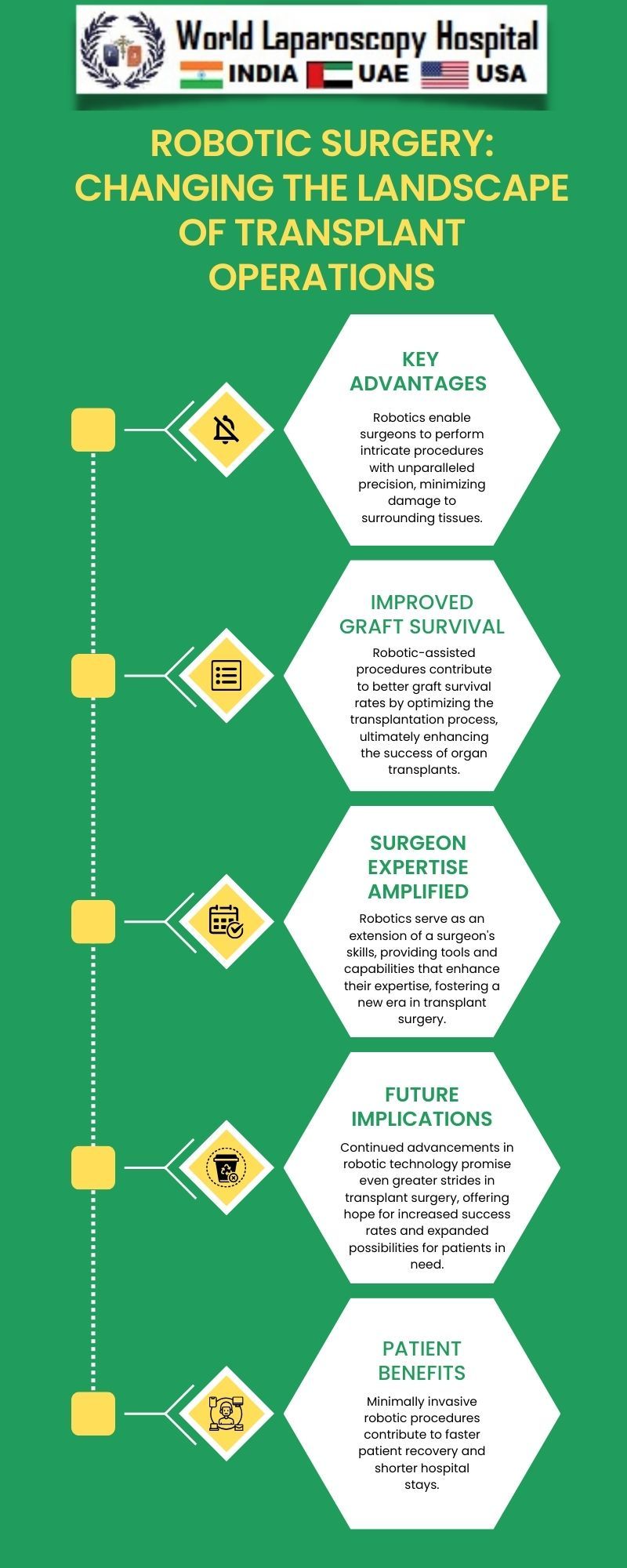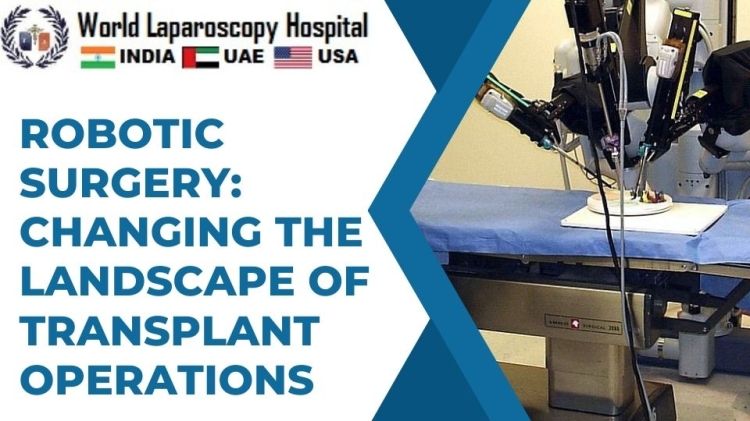Robotic Surgery: Changing the Landscape of Transplant Operations
Introduction:
In the realm of medical innovation, robotic surgery has emerged as a groundbreaking technology that is fundamentally altering the landscape of transplant operations. The integration of robotics into surgical procedures has ushered in a new era of precision, flexibility, and enhanced outcomes. This article explores the multifaceted impact of robotic surgery on transplantation, examining its evolution, current applications, benefits, challenges, and the potential it holds for the future of medical interventions.

Evolution of Robotic Surgery in Transplantation:
The concept of using robotic systems in surgery dates back to the mid-20th century. However, it wasn't until the late 20th and early 21st centuries that robotic surgery gained significant traction. The da Vinci Surgical System, introduced in 1999, marked a pivotal moment in this evolution. Initially designed for urologic procedures, it quickly found its way into other surgical specialties, including transplantation.
The da Vinci System and its counterparts have revolutionized transplant surgery by providing surgeons with a high degree of precision, three-dimensional visualization, and increased dexterity. These robotic platforms consist of a console where the surgeon sits, a robotic arm system, and a camera system that provides a magnified, high-definition view of the surgical site.
Current Applications in Transplantation:
Robotic surgery has found applications in various types of transplant procedures, ranging from kidney and liver transplants to heart and lung transplants. One of the key advantages is the ability to perform minimally invasive surgeries, where small incisions are made, leading to reduced scarring, less pain, and faster recovery for the patients.
In kidney transplantation, robotic-assisted procedures have become increasingly common. Surgeons can use the robotic arms to meticulously dissect blood vessels and connect the donor kidney to the recipient's blood vessels and bladder. The precision offered by robotic systems minimizes damage to surrounding tissues, optimizing outcomes for both donors and recipients.
Liver transplantation, a complex and intricate procedure, has also benefited from robotic assistance. Surgeons can navigate through the intricate network of blood vessels and bile ducts with heightened accuracy, resulting in improved graft survival rates and reduced postoperative complications.
Heart and lung transplant surgeries, traditionally performed through open-heart procedures, have witnessed a paradigm shift with the introduction of robotics. The ability to conduct these surgeries with smaller incisions reduces the risk of infection, accelerates recovery, and enhances overall patient satisfaction.
Benefits of Robotic Surgery in Transplantation:
Precision and Accuracy:
Robotic surgery enables unparalleled precision and accuracy, allowing surgeons to perform intricate tasks with enhanced control. This precision is crucial in transplant operations, where delicate connections and sutures are required for optimal outcomes.
Minimally Invasive Procedures:
The minimally invasive nature of robotic surgery is a game-changer in transplantation. Smaller incisions result in reduced postoperative pain, faster recovery times, and diminished scarring for transplant recipients.
Improved Visualization:
The three-dimensional, high-definition visualization provided by robotic systems enhances a surgeon's ability to navigate complex anatomical structures. This improved visualization contributes to better decision-making during the surgery.
Reduced Blood Loss:
The meticulous control offered by robotic instruments helps minimize blood loss during transplant procedures. This is particularly significant in surgeries where vascular anastomoses play a crucial role.
Enhanced Dexterity:
The robotic arms replicate the movements of the surgeon's hands with precision and eliminate natural hand tremors. This enhanced dexterity is invaluable in tasks that demand meticulous handling of tissues and vessels.
Challenges and Considerations:
While the benefits of robotic surgery in transplantation are substantial, it is essential to acknowledge and address the challenges associated with this technology.
Cost Implications:
The initial investment and maintenance costs of robotic surgical systems are high. This can pose financial challenges for healthcare institutions, limiting widespread access to this advanced technology.
Learning Curve:
Surgeons need extensive training to become proficient in robotic-assisted procedures. The learning curve can be steep, and the time investment required may act as a barrier to the adoption of robotic surgery.
Lack of Tactile Feedback:
One of the limitations of current robotic systems is the absence of tactile feedback. Surgeons rely on visual and auditory cues, but the sense of touch is compromised. Overcoming this limitation remains an area of active research in the field.
Equipment Limitations:
While robotic systems offer advanced capabilities, there are certain limitations in terms of the size and range of motion of robotic instruments. Innovations in robotics continue to address these limitations for more versatile applications.
The Future of Robotic Surgery in Transplantation:
As technology continues to advance, the future of robotic surgery in transplantation looks promising. Several areas of development and research are shaping the trajectory of this field.
Artificial Intelligence Integration:
The integration of artificial intelligence (AI) into robotic surgery holds immense potential. AI algorithms can assist surgeons in real-time decision-making, analyze data, and optimize surgical outcomes based on a vast repository of medical knowledge.
Haptic Feedback Enhancement:
Addressing the lack of tactile feedback is a priority in ongoing research. Innovations in haptic technology aim to provide surgeons with a sense of touch, enabling them to feel the resistance and texture of tissues during robotic procedures.
Remote Surgery:
Remote robotic surgery, where surgeons can operate on patients from a different location, is an area garnering significant interest. This could revolutionize transplantation by enabling expert surgeons to perform procedures on patients in remote or underserved areas.
Cost Reduction Strategies:
Efforts are underway to explore cost-effective solutions for robotic surgery, making this technology more accessible to a broader range of healthcare institutions. Collaborations between technology developers and healthcare providers play a crucial role in achieving this goal.
Conclusion:
Robotic surgery has undeniably changed the landscape of transplant operations, offering a myriad of benefits that translate into improved patient outcomes and satisfaction. The evolution of this technology has brought about a paradigm shift in the way surgeons approach complex transplant procedures. While challenges exist, ongoing research and technological advancements promise to overcome these obstacles, opening new frontiers for the integration of robotics into the future of transplantation. As we stand on the cusp of further innovation, the synergy between human expertise and robotic precision holds the key to transforming the field of transplant surgery and, by extension, the broader landscape of medical interven
